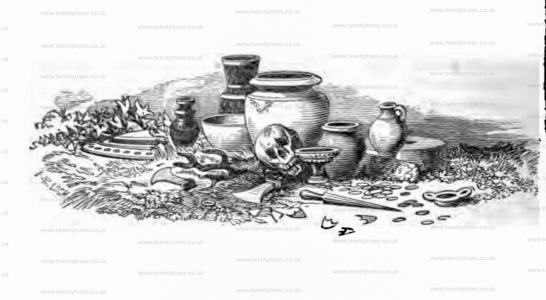Section I Tumuli 1846
Section I Tumuli 1846 is in Section I Tumuli.
Section I Barrows Opened by Mr Thomas Bateman (age 24) in 1846.
On the 18th of July, 1846, two barrows in the neighbourhood of Wetton, Staffordshire, were opened, which, although not containing any objects of British manufacture, save rude flint instruments, and being even destitute of human remains, still present a new and unaccountable feature in the annals of barrow-digging, the uniformity of which in two instances entirely precludes the opinion of the deposits being accidental. The first opened was a small circular barrow situated near "Thorns Cave [Map]," in Wettondale (a wonderful example of nature's architecture). The mound was raised upon the surface of the rock, by heaping up a collection of stones, amongst which were many boldered ones, apparently brought up from the neighbouring watercourse; there was a small excavation in what is technically called a soft joint in the rock, which contained a single jaw-bone of an ox, or cow, close to which lay a piece of flint; this was the only trace of animal remains in the barrow.
The other mound was of the kind familiarly known as the "Long Barrow [Map]" being of a lengthened oval form; it was on much less elevated ground, and nearer to the village than the former one; there was no cist, or other receptacle for a body to be found, but at one extremity, upon the surface of the natural soil, was laid a similar jaw-bone to the one just mentioned; on it was a rudely-chipped instrument of light coloured flint, and around it were a few rats' bones. These deposits seem to be of the same nature as that of a bulls head [Map] discovered on Ilam Moor on the 12th of July, 1845, and might possibly have been dictated by some superstition with which we are now entirely unacquainted.
On the 20th of July, 1846, were opened two barrows, upon Stanshope Pasture, near Dovedale, Staffordshire. The first [Note. Probably Stanshope Barrow 1 [Map]] is of considerable magnitude, and appeared beautifully perfect, but, as is not unfrequently the case under similar circumstances, proved entirely deceptive. A natural elevation in this rocky neighbourhood having been taken advantage of in the construction of this barrow, and trimmed into form, consequently the greater part of it was solid rock, and the small portion of soil which had been added had been much disturbed at some prior excavation. In one situation in the interior of the barrow, the rock seemed to have been slightly cut, in order to form a cist, and here were found the only traces of interment that were met with; namely, a small piece of a coarse urn, some calcined human bones, and various pieces of flint, which had undergone the same process.
The second barrow [Note. Probably Stanshope Barrow 2 [Map]] was at the distance of about five hundred yards from the foregoing, and had been entirely removed to the surface of the ground whereon it stood; on digging, however, in the centre, it was found to descend a few inches in a dish-like form, at which point a few pieces of human bone, the fragments of a skeleton, and some pieces of a small cup of Samian ware, probably of Romano-British manufacture, were found. Owing to the barrow having been taken away, these things were in a lamentably shattered condition, which is the more to be regretted, as this is the only instance of Samian ware being applied to a sepulchral purpose as yet brought to light in the counties of Derby or Stafford.
On the 29th of July, 1846, was examined a large tumulus at Castern [Note. Castern Barrow [Map] has no tumulus marked near it on the OS Map?], near Wetton, Staffordshire, distant about a quarter of a mile from that opened near Castern [Map] on the 14th of June, 1845 (on which occasion the one under notice first attracted attention); it was composed principally of a very solid kind of soil, intermixed with clay, amongst which were dispersed many chippings of flint, as well as others of a more determinate form; also a few animal bones, such as fragments of deer's horns, teeth of horses, &c. Towards the centre the stiff earth did not prevail so much, that part of the mound being constructed of loose stones, which were found to continue below the natural surface, to the depth of four feet, making an entire depth of eight feet from the summit of the barrow; at this depth lay the original and most important interment, in a square cist cut out of the primitive rock; the skeleton lay upon its left side, on a thin bed of very tenacious blue clay, with the knees contracted, accompanied by the most elegant and elaborately ornamented drinking-cup, or vase, hitherto discovered and one small instrument of calcined flint; the vase was placed in an upright position about a foot in the rear of the skull, and exhibited signs of having been two thirds full of some substance, or rather liquid, at the time of being buried, an incrustation having formed inside, at about one third of its depth from the mouth. The skeleton was that of an individual rather above the common size, the large bones of the thigh measuring in length nineteen inches and a half, and all the bones having the ridges and other points of muscular attachment remarkably well developed. At a short distance from the centre of the barrow there was every appearance of the remains of a fire which had been made upon a flat stone, surrounded by others, the edges of which were calcined until they were converted into lime. Can this be the place where the drinking-cup was baked? - there were certainly no calcined bones to be seen. Another body was found in a similar position to the foregoing, within six inches of the summit of the tumulus; it owed its preservation mainly to a large flat stone which was placed over it, and which was literally destitute of turf, and exposed to the observation of any person walking over the barrow. Neither urn nor weapon accompanied this interment.
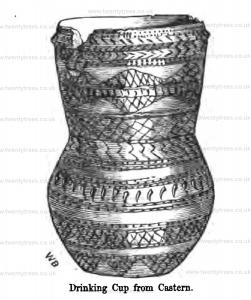
On the 12th of August 1846, was opened a low flat barrow at Windle (Wind Lowe) Nook [Map], near Hargate Wall, Derbyshire, about twenty yards in diameter, two feet high, and encircled by a ring of large flat limestones, placed in a sloping manner on one side, about three yards from the margin of the tumulus, apparently for the purpose of preserving its symmetry. The top of this barrow is surmounted by a large square sandstone, which has originally formed the base of one of the wayside crosses, of which numerous examples remain in the north of Derbyshire. About the centre of the barrow was a cist, measuring near six feet by four, in horizontal area, and three feet in depth, of unusual construction, the sides being built of large stones set on end, some of which appeared above the turf; an examination of the contents of this cist led to the conclusion that it had been applied to sepulchral purposes at various distinct periods, and that the last interment had been partially disturbed at a comparatively recent period; the contents were as follows: small pieces of urn, calcined bones and flints, skeletons of two persons of full stature, and of two infants, one of them very young, and various animal bones, amongst which, those of the rat, weasel, and horse were most conspicuous. All these articles were so much out of their ordinary arrangement, as to leave no doubt of their disinterment at the time of the burial of another skeleton, which lay in a contracted position a few inches above the floor of the vault; this skeleton, which, from the ornaments discovered with it, and the slender proportions of the bones, must be attributed to a female, had not entirely escaped spoliation at a recent period; the following circumstances seem to put this question beyond doubt, namely, the discovery of sundry pieces of tobacco-pipe, and nails from rustics' shoes, and from the fact of finding part of a very large ivory pin, and a fragment of an armilla or bracelet of Kimmeridge coal, both of which would undoubtedly have been perfect at the time they were deposited. Whoever these former excavators were, they were not very close observers as they had overlooked a necklace of beads of the aforesaid Kimmeridge coal, terminated by two perforated conical studs of the same, and enriched by six pieces of ivory, ornamented with the everlasting chevron or zig-zag pattern so universally prevalent on Celtic remains. The beads, exclusive of the studs and ornaments, are seventy-six in number, and are identical with two that are figured in plate 3, vol. i of Sir. Richard Hoare's excellent work. The ivory ornaments are quite novel, no other example having been published.
Note. The necklace discovered at Wind Low on display at Weston Park Museum, Sheffield.
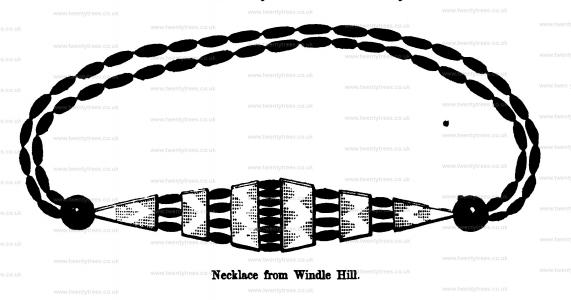

On the 15th of August 1846, another barrow [Bole Hill Barrow [Map]], on higher ground, a little farther on the opposite side of the road to Buxton, was opened. Its diameter is greater than that of the last, but, like it, is surrounded by a circle of very large stones. In the centre was an erection of very large flat stones, regularly walled in courses, and having for its base a piece of rock four feet by five, and one foot thick, approaching to a ton weight, so that if the earthy part of this barrow had been carefully removed so as to leave these stones undisturbed, there would, according to the old school of antiquarianism, have been a complete druidical circle, with a cromlech or altar for human sacrifices standing in the centre; more particularly, as the flat stone at the top of the central pile had a considerable inclination towards one side, which peculiarity in similar structures has been gravely accounted for as an intentional provision to carry off the blood of the unfortunate victims now and then sacrificed by the Druids. But to return to the funereal discoveries made in this barrow; on removing the aforesaid large stone, a few pieces of an unusually coarse urn, some calcined human bones, and the remains of a host of rats, with here and there a skull of the weasel, appeared; though level with the surrounding field, the earth under the stone was loose, and had been removed to form a cist, 'which had for its floor a level surface of rock, some three feet below the natural soil, and which was neatly walled round with flat stones; in this grave was a skeleton of large dimensions, lying on its left side, in a contracted posture; behind the head was a brass dagger of the usual type, measuring six inches and a quarter in length, and in the highest preservation; it has the appearance of having been silvered, and still retains a brilliant polish; when deposited it had been inclosed in a wooden sheath, the remains of which were very perceptible at the time of its discovery. Near it were two instruments of flint, and two more were found during the progress of the examination of the tumulus.
On the 19th of August 1846, was opened a barrow [Map] [Note. Bole Hill Barrow 2 [Map]] near the last, much mutilated by the removal of a quantity of stone for fencing, at the time of the inclosure of the common, when, if report be true, two celts of bronze were here discovered. A considerable portion of the circle still remaining, gave hopes of something still untouched, and to be obtained without much labour; but upon examination, the unremoved part of the mound proved to be mainly undisturbed rock, slightly covered with stones and soil, amongst which were found two skeletons, one male, the other female; the former lay close to the turf, and was of course much decayed and broken; the latter was deeper, in fact, it lay upon the surface of the rock, and was in much better preservation; near them were some small pieces of flint, and one small piece of an urn. Below that part of the tumulus that had been carried away was a small deposit of calcined bones, accompanied by those of the rat.
On the summit of Five Wells Hill [Map], near Taddington, is one of the most perfect examples now existing of the sepulchral architecture of the aboriginal inhabitants of Britain; it consists of two vaults situated in the centre of a cairn about thirty yards in diameter, each approached by a separate gallery or avenue, formed by large limestones standing edgeways, extending through the tumulus, respectively in a south-east and north-west direction. This structure appears to have been first discovered at the time of the inclosure of the moors, when a great part of the barrow was used in making the surrounding fences; at this time many bones were found in the vaults.
On the 25th of August, 1846, the two galleries were cleared out, in order to ascertain if any articles had been overlooked by the parties who first opened the barrow; but, with the exception of a flint arrow-point, and numerous bones, some calcined, nothing of primitive date was discovered. The quantity of bones of both sexes and of various ages indicate this tumulus to have been used as a burying-place for a considerable time; on this occasion the lower jaws of twelve different persons were collected.
On the 29th of August 1846. The barrow at Cow Lowe [Map], near Buxton, was opened; although a little disturbed on the surface by the operations of stone-getters, the interments were quite intact. The number and importance of these deposits render needful a minute description of most of them, and a chronological arrangement will make each particular much more intelligible; by the latter system, we commence with the presumed primary interment, then tracing each succeeding one, in the order in which it was inhumed, instead of relating the particulars of each, in the rotation in which they were brought to light by the spade. Upon the floor of the barrow, which slightly exceeded the depth of four feet from the summit, was laid apparently the primitive interment, covered over with a large flat stone, but not inclosed in a cist; it was the body of a person of small stature, probably a female, with the knees contracted; it altogether rested upon a layer of calcined human bones, amongst which was found a bone pin, which had been perforated at the thicker end, but now broken, and part of a dog's head, also several horses' teeth; a few inches higher up, the whole of the centre of the tumulus was covered with human bones, unaccompanied by anything worthy of notice, if we except a few pieces of an urn, coarse, both in material and workmanship. The number of jaw-bones belonging to different skeletons in this part of the barrow was five, though it is probable that a greater number of individuals were here interred. About a foot higher than these, and slightly out of the centre of the barrow, was a small cist, made of stones set edgeways, which contained the bones of a female in the usual contracted position, with which were two sets of Kimmeridge coal beads (one hundred and seventeen in number), of very neat workmanship; the central ornaments are in this case made of the same material as the beads, though it will be remembered that, in the similar ornament found at Wind Lowe [Map], the central plates were of bone or ivory; a faintly marked diamond pattern is discernible upon the plates of shale; with these lay a fine instrument of calcined flint, of the circular-ended form; a few of the beads lay on the outside of the cist, where was part of the skeleton of a child, to whom possibly one set of beads might belong, or, what is more probable, that they were disturbed at the time of the construction of the hexagonal cell, which was placed partly upon the cist pertaining to the lady, at a slightly higher level; in it were deposited two skeletons, one above the other, much crushed up in order to accommodate them to the confined limits of the cell; with the lower one was a neatly ornamented urn of unbaked clay, much decayed and broken. The latest and most interesting interment, which may be attributed to the Romano-British period, or perhaps by some antiquaries to the early Saxon era, lay in the centre of the harrow, and about midway between the surface of the natural ground and the top of the former; the bones were mostly decayed, so much indeed, as to leave no trace except the teeth, and a small portion of the cranium; near which, probably about the neck, were two pins of gold, connected by a chain of the same, of remarkably neat design and execution; the heads of the pins contain a setting of many coloured glass, platted upon a chequered gold foil; close to them, and apparently having slipped off the chain, by a large bead of blue glass. The earth for a few feet from this place appeared to have been tempered with water, or puddled, at the time of the funeral, which gave it a very solid and undisturbed appearance; this, coupled with the absence of bones, makes it difficult to decide near what part of body the following articles were originally placed; they were about eighteen inches distant from the pins, which were certainly close to the head. These articles had been inclosed in a wooden box, made of ash plank half an inch in thickness, which was wrapped in a woollen cloth, the warp of which is perfectly visible; the hinges of this casket (two in number) are of brass, and were fastened with brass pins, which were clenched upon a piece of stout leather in the inside of the box; it was fastened by a brass hasp of similar type to the hinges, which received a small staple, to which was hung an iron padlock; it contained a small vessel of thick green glass, an ivory comb much decayed, some instruments of iron, a piece of perforated ivory, apparently the end of some utensil, which was encircled by a brass hoop at the time of its discovery, but which fell to dust on exposure, and a neck decoration of various pensile ornaments, eleven in number; the centre one is of blue porcelain or glass, with three serpents in white; it is retained in a setting of silver, with vandyked edges, on either side of this is a spiral wire bead of electrum, whilst the suit is made up of small circular pendants of silver, extremely thin, each having a level back and a convex front, and each stamped out of a separate piece; of these the number is eight, and with the exception of one, which has a beaded circle running round it, are all struck from the same die, a small flaw being visible on each; the box also contained a dog's or fox's tooth; and a short distance above the body, in the same tempered earth, lay a portion of the horn of the red deer. In various parts of the tumulus, but not in situations where they could be allotted with certainty to any of the interments, were found a scattered deposit of burnt bones, a bead of Kimmeridge coal, of more globular form than the others, much worn, a neat pin of bone, a pointed instrument of the same, apparently a lance-head, and the usual chippings of flint, and rats' bones.
Note. Necklace, possibly, from Cow Low on display at Weston Park Museum, Sheffield.
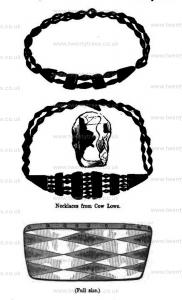
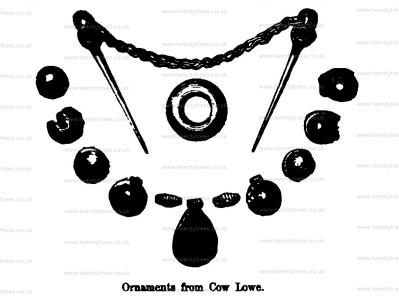

On the 1st of September, 1846, was opened an apparently large barrow near Taddington, called Priestcliffe Lowe [Map]; on being dug into, the rock was found to extend almost to the surface of the barrow, and the light covering of soil and stones, to have been previously disturbed; nothing having been overlooked but a small piece of a very neatly-ornamented urn and a few burnt bones.
On the same day two barrows on a very elevated piece of land on Wormhill Moor, known by the name of Whithery Lowe [Map], were opened; the smallest is situate on the highest point of the hill, and is formed almost entirely of soil, with here and there a stone. In it no symptoms of sepulchral remains were observed. The larger one is nothing more than the base of a considerable tumulus which has been removed to within eight inches from the natural soil; in the centre there was still remaining a cist, with a level floor formed of a slab of limestone; in this were the remains of two bodies, one of them a female, both which had been broken and disturbed at the time of the removal of the upper portion of the barrow.
On the 5th of September, 1846, was examined the lower part of a large barrow (called Dowe Lowe) [Note. Dow Low Barrow [Map]] near Church Sterndale; the upper part of which had been some time removed, on which occasion an urn and other antiquities were found; fortunately the primary interment was left untouched; though the remnants of later interments deposited on a higher level, consisting of sundry pieces of bone, burnt and unburnt, fragments of urns, and a small piece of thin cylindrical brass, testified to the havock that had been made. The most remote interment consisted of two much decayed skeletons, lying near each other upon the floor of the barrow, about two yards from the centre; one was accompanied by a fluted brass dagger, placed near the upper bone of the arm, and an amulet or ornament of iron ore, with a large flint instrument, which had seen a good deal of service, lying near the pelvis. A few chippings of flint and calcined ];|Luman bones were distributed near the two skeletons.
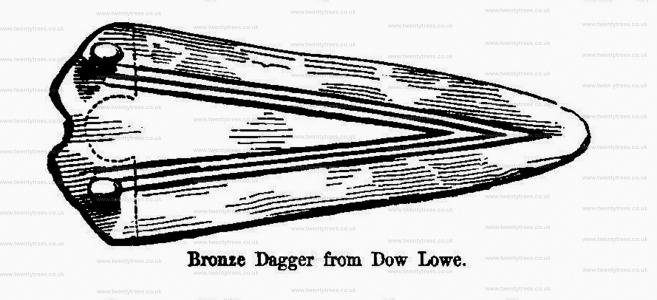
Upon the hill called Lowe, above the village of Chelmorton, there are two considerable cairns or barrows of stone [Note. Chelmorton Low Round Barrow 1 [Map] and Chelmorton Low Round Barrow 2 [Map]], standing within fifty yards of each other, neither of which is altogether covered with turf, notwithstanding the immense time which must have elapsed since they were piled in their present situations; consequently they convey a very clear idea of the appearance of this kind of tumulus in its pristine grandeur, and therefore cannot be looked upon without at once carrying the mind back through a score of centuries, until one would hardly feel surprise at seeing a Druid or a British hunter stop in his solitary path across the hill to pay his tribute of respect to the hill of graves. Owing to the large size and loose construction of the most considerable one it was found unadvisable to devote any time to its elucidation as a single day would be far from sufficient to penetrate to its centre. The other being more accessible, was singled out as the object of research on the 9th of September, 1846, and though removed to the rock, for a considerable extent, it did not present more tokens of intermentlian one or two fragments of calcined bone, a neat lance-head of flint, and numerous rats' bones, all which were found about the centre. There is strong reason to presume that this barrow had previously undergone examination, although there is no record of such a circumstance having taken place.
On the 12th of September, 1846, was opened a small barrow near Wetton, Staffordshire, called Slip Lowe. In this instance, as is generally the case in that vicinity, the dst was found to be sunk to the depth of three feet in the solid rock, instead of the more usually employed method in other places of constructing a vault above the soil or rock by loose stones. The cist contained the skeleton of a young person, apparently aged about eighteen years, whose body had been deposited in a contracted form, and was accompanied by two arrow-heads of flint, and various animal bones, amongst the latter, the beak of a bird, of the falcon species, attracted particular attention, the occurrence of remains of this kind being very unusual, though certainly before observed in tumuli in the same district. A few fragments of stag's horn were distributed tluroughout the barrow, and near the surface a small piece of firmly-baked urn of late style was picked up.
On the 19th of September, 1846, was opened a small barrow [Map] [Note. Narrowdale Barrow [Map]] upon the summit of Narrow-dale Hill, near Alstonefield, Staffordshire. It was not more than eighteen inches higher than the surface of the hill; in the centre, inverted over a deposit of burnt bones, was a large unornamented urn, which rested upon a large stone level with the rock; a flint spear of primitive form was deposited along with the bones beneath the urn. The large stone being removed was found to be the cover of a cist cut down in the rock and filled with soil; on displacing which, another deposit of calcined bones, containing a small piece of burnt flint was found heaped up on the floor of the cist; at one comer of this vault stood a neatly-ornamented urn in perfect condition. On the Alstonefield side of the tnmulus a neat little cist was found; which was made of four flat limestones set on edge to form the sides, and a fifth to serve as a floor, on which lay a heap of burnt bones, which had originally been protected by an urn, now entirely disintegrated by atmospheric changes, its near proximity to the surface having subjected it to their influence. Amongst the heap of bones were a neat arrow-head of flint, a bone button or ornament perforated with three holes for attachment to the dress, and a piece of stag's horn; in this barrow were many rats' bones, and a few bones of a human skeleton which had not undergone combustion.
On the 22d of September, 1846, was opened a very large barrow upon Hind Lowe, near Sterndale, which was entirely composed of a tenacious soil, similar to those opened at Bassett Wood [Map] and Newton Grange [Map] in 1845. An excavation was made in the centre to the depth of seven feet, where the natural soil became apparent, without meeting with any interment; one rude arrow-head of flint occurred about three feet from the summit of the tumulus.
On the 26th of September was examined a small artificial mound near Buxton, called Staden Lowe [Map], in the immediate neighbourhood of which are some earthworks of early date. The "Lowe" did not present any appearance of having been applied to funereal purposes, as the name would indicate.
On November 30th, 1846, were opened two barrows near Middleton, upon the Calling Lowe Farm, which probably has acquired the denomination of "Lowe" from the presence of these two tumuli, doubtless once well known and venerated. The first barrow [Map] [Note. Calling Low Barrow 1 [Map]] is situate near the edge of the Lowe Dale, at the termination of a stony ridge, which has been taken advantage of in forming the shape of the tumulus, without the expenditure of much labour. The skeleton, with the knees drawn up lay on its right side, in an oblong cist, the extremities of which were respectively north-east and south-west, and which was constructed of flat limestones, arranged in a depression in the rock, about eighteen inches in depth, near the centre of the barrow; near the pelvis were two instruments of calcined flint, namely, a spear-head and a circular-ended instrument, and above the body lay the bones of a dog's hind leg, and a round ball of sandstone about two inches and a half in diameter. Many rats' bones accompanied this interment which, owing to its proximity to the surface, was very much decayed.
The other barrow [Map] [Note. Calling Low Barrow 2 [Map]] is a lowly sepulchre, not rising more than a foot above the surrounding field, and situated nearer the Yolgrave and Buxton road than the preceding one is. About two feet from the surface, in the centre, and consequently beneath the natural level, was a skeleton inclosed in a mass of stiff earth, which had almost effected the destruction of the bones; near the pelvis of this body a rude instrument of calcined flint was found; it was the only relic deposited with this interment, which had, undoubtedly, supplanted the rightful occupants of the tomb: this circumstance was proved by the discovery of the remains of two previous interments, which had been thrown on one side to make room for the intruder. These I relics comprised many pieces of two unbumt skeletons, parts of two highly-ornamented drinking-cups, and many bones of animals, amongst which the remains of rats were as usual most numerous.
On the 7th of December, 1846, a barrow was opened which is situate upon the extremity of a hill-side near Middleton, called Moot Lowe Bank [Map]. There were very slight appearances upon the surface of the ground of anything of the kind, in fact, the sepulchral nature of the place was accidentally discovered by a labourer engaged in quarrying stone in the hillside. On examining the surrounding rock, a false joint, about two feet wide, became apparent, which extended a distance of seven yards in an oblique direction up the side of the hill; this joint had been filled in with stones and soil, amongst which many bones of animals occurred, all of the same description as are usually found in tumuli; near the upper end of the joint was placed a human skeleton doubled up in the usual primitive manner, close to whose head were four or five cows' teeth. Nothing more than these appeared to have been deposited with the body, which was that of an adult male.
In the early part of February, 1847, a small tumulus [Map] [Stanton Moor Barrow [Map]] was levelled by labourers cultivating waste land upon Stanton Moor. The barrow was of small size, mostly constructed of stone, and inclosed a small square cist of sandstones, which contained a small vase or urn imbedded in fine red sand. This urn was broken to pieces whilst being removed. The fragments present a new feature in style of ornament, the indentations being produced by means of the thumb nail, which was applied to the clay whilst in a soft state.
On the 6th of February, 1847, a barrow [Map] [Flax Dale Barrow [Map]] was opened which is situated in the township of Middleton-by-Yolgrave, near a small valley called Flax-dale. It is of the usual bowl-shaped form, and is about three feet in height. Near the centre was found a fine sepulchral urn, neatly ornamented, containing a deposit of calcined bones, over which it was placed, with the mouth downwards. The urn was inclosed within a rude cist, partly cut in the rock, partly walled round, and covered with a large flat stone; about this and indeed throughout the barrow were many pieces of flinty some of which are chipped into the shape of arrow-heads &c. The presence of rats' bones indicated that there had been an interment by inhumation in addition to the foregoing one. Part of a skull and a few bits of pottery were all the vestiges of this deposit which appears to have been disturbed at the time of the interment of the urn and its contents.
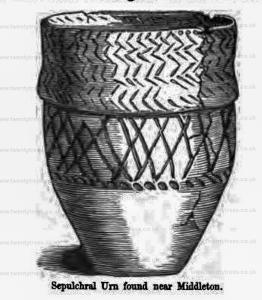
On February 20th 1847 was opened a barrow [Map] [Brundcliffe Barrow [Map]] near Bruncliff in Hartington parish which was raised to a height of upwards of three feet above a grave or cist cut in the rock and descending about two feet below the natural surface thus giving a depth of rather more than five feet of factitious earth from the summit to the floor of the tumulus. About eighteen inches beneath the turf was a deposit of calcined animal bones accompanied by a great quantity of charred wood. From the discovery of a perfect tooth amongst these remains it appears that the victim in this instance had been a young horse. About the same level occurred a small piece of pottery and a point or tine of a stag's horn. Upon the floor of the grave lay a human skeleton which appeared to have been extended at full lengthy and to have been laid upon its back with the arms straight down the sides; this however is not quite certain, as the decayed and mouldering state of the bones rendered any very accurate observations impossible. To the left of the pelvis lay a narrow-necked vessel of red clay having a lip for the convenience of pouring out liquid; this was placed in a horizontal position with the mouth towards the upper part of the skeleton; in contact with it lay a curved iron knife, six inches in length, with a wooden haft much decayed. Close to the tibia or leg-bone was placed an article principally composed of iron and wood, the use of which is by no means obvious, upon one part of it is a small silver cell or settings which had retained a stone or gem of some description.
From the very evident traces of decayed planks around the bones, it is highly probable that the body had been protected by them, if not inclosed in a coffin of more regular construction. The vessel appears to have had a handle, which was broken off and smoothed down previous to its interment; it bears marks of being a copy firom a classical model, and has been turned upon a potter's wheel, an invention probably unknown to the Celtic tribes previous to the Roman conquest.
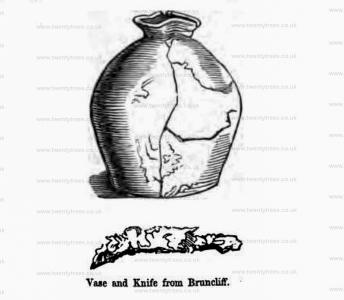
The barrow at Lean Lowe [Map], opened on the 17th of June,, 1843, without any decisive results, was again excavated on the 23d of February 1847; when the operations were confined to the north side of the tumulus, a part previously unexplored. About eighteen inches beneath the surface was found a small urn of very coarse clay, neatly ornamented, deposited in a rude cist formed of four large stones; around the urn were many pieces of calcined bone, which did not appear ever to have been placed within it; on the contrary, it contained some splinters of animal bones, which were free from the action of fire, and a small knife of black flint. Laid upon the rock, about a foot deeper than the vase, was a human skeleton, in a contracted position and imbedded in rats' bones, but unaccompanied by any kind of relic. These bones were the remains of a young person, whose age probably did not exceed sixteen years, and whose teeth are beautifully regular.
On the 6th of March, 1847, a small excavation was made within the circle inclosed by the six stones standing in the "Nine Stone Close [Map]" upon Harthill Moor, with a view of noting the claim of such stone circles to be considered sepulchral structures. The result in this instance was favorable to this opinion of their origin and purpose as several fragments of imperfectly-baked pottery, accompanied by pieces of flint, both in a natural and calcined state, were dug up.
These remains probably would have been more complete, had not the repeated passage of the plough in the progress of cultivation materially reduced the height of the land within the inclosed area.
On the 17th of the same month a very remarkable tumulus was visited, which is situated upon a piece of ground near the village of Monyash, called Ringham Lowe [Map]. The upper portion being removed, it now presents the appearance of an oval elevation of considerable extent and trifling height, bearing in its present state no slight resemblance to the temple at Arbor Lowe, this idea being strengthened by the immense stones of which the kistvaen is composed.
The oval measures about fifty-four yards by thirty-five, and is thickly studded with vaults of the usual construction, many of which radiate from the central part of the barrow, where one of rather superior size is placed. The latter was cleared out on the above-mentioned day, and was found to consist of four large stones; the one employed to form a side of the cell was ascertained to measure four yards in length, from four to five feet in width, and two feet in thickness; within lay the skeleton of a very old man, upon a flooring of flat stones; with him a small piece of gray flint, apparently a part of a knife, and a cow's tooth. These bones retain much of their natural appearance, being hard and sound, excepting at the ends, which are entirely removed by decay. Two other vaults were opened without success, and in no part of this barrow which could be examined were any traces of calcined bone or pottery apparent.
Near one extremity of this oval tumulus is a small barrow, as at Arbor Lowe; it is much flattened by cultivation, and on opening afforded no relics, its contents being merely a disjointed human skeleton amidst a profusion of rats' bones.
On March 19th three unimportant barrows in the neighbourhood of Thorpe were opened; the first of which, placed in a low situation, was composed solely of earthy in which fragments of charcoal were apparently the only indications of its haying been raised by man.
The next was on more elevated ground had been partially removed and produced some trifling remains of bone and a small piece of Samian ware much worn.
The last one placed in the hollow between two hills, contained numerous human bones chiefly from the extremities, and a few teeth which indicate the interment of an infant and a full-grown individual.
Upon the 1st of April, 1847, a large tumulus [Map] [Gotham Barrow [Map]] near Ghotam was opened, rising about five feet above the natural level of the land, through which a cist was sunk into the rock to a further depth of four feet, and was filled in with stones of great magnitude, thus rendering the excavation extremely difficult, not to say dangerous.
This cist not being in the centre, probably corresponds to another of the same kind on the opposite side of the barrow, of which there are indications; want of time would not on this occasion allow of its investigation. The level in the middle of the tumulus appeared to have been covered with a large fire and upon it were found several teeth of a cow, two rude instruments of flint, and a piece of stag's horn, which has been cut by a saw of flint, or some such primitive instrument. After much labour the bottom of the cist was reached, at a depth of upwards of nine feet from the surface of the barrow, where, by the help of a candle, part of a human skeleton was obtained from beneath an immense stone which could not be removed; fortunately, the excavation exposed the upper extremity of the skeleton, about which the appendages are almost always deposited in the Celtic tumuli in this part of England, so that there is very little probability of anything having been overlooked. The articles in this case were of very meagre quality; in fact, two pieces of stag's horn, the one being a tine rudely broken off the stem, and the other consisting of two branches upon a piece of the horn neatly cut out of the entire antler.
Upon a more complete investigation of this barrow (on the 23d of August, 1847) another interment was discovered in a similar cist on the opposite side of the mound, as was anticipated on the previous occasion. The mode of burial was in each case similar both bodies having been laid at a depth of nine feet from the summit, and covered with numerous large stones. In this instance the skeleton lay on the left side, in a contracted position, with one aim beneath the head, and near the thigh-bones were found a neatly-chipped spear-head of gray flint, and a small bronze pin, which had been inserted into a wooden handle.
Nothing else worthy of notice occurred in the progress of the excavation.
On the 30th of August a stony barrow [Map] [Pilsbury Hill Barrow [Map]] upon a hill near Pilsbury, in the parish of Hartington, was opened. The surface of the land upon which the barrow stands is rendered very uneven by irregular rocks which appear above the soil. Between two of these masses, in the centre of the mound, lay two interments, one of which had been disturbed; the other was in its original situation, and was accompanied by a heap of calcined human bones placed at the feet, besides which nothing else was found.
Another interment had taken place on the exterior of the original mound, which had been increased by the addition of a smaller tumulus covering these more recent remains, which consisted of the bones of a man laid at full length, who, from the circumstance of his having been possessed of an iron knife, which was placed near his left side, it is probable lived in times subsequent to the Roman conquest.
On the same day was opened a small barrow [Map] [Pilsbury Farm Barrow [Map]] adjoining the river Manifold (also upon the Pilsbury Farm). It consists entirely of gravel collected from a neighbouring hill-side, and heaped upon the natural soil, on the level of which much charcoal occurred, evidently the ashes of a considerable fire. Nothing more than this indicating an artificial origin was discovered.
Upon reopening the remains of a barrow [Garratts Piece Barrow [Map]] upon Middleton Moor, explored by Dr. Pegge in 1788, on the 5th of October, 1847, a few small articles were recovered which indicate that the tumulus existed in times long anterior to the deposit of the very remarkable Saxon antiquities therein discovered and described in the earlier part of this section and which farther tend to strengthen the idea that in this part of the country there exist no barrows purely of Saxon origin. The articles with, the exception only of some fragments of light-coloured kiln-baked pottery, are of Celtic manufacture and usage, consisting of pieces of stags' horns, instruments of flint, amongst which was one of elongated shape very neatly chipped; and, lastly, remains of bone instruments, one of the latter presenting a very neat example of the lance-head of that material, being nicely worked into form out of the leg-bone of some small animal. Similar points are seen to some of the arrows brought from New Zealand.
